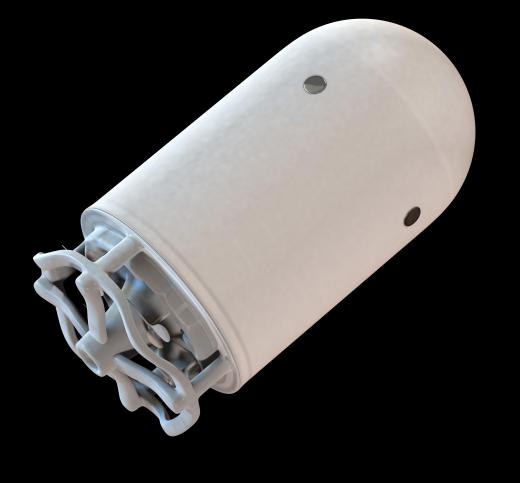What is the Difference Between Nanotechnology and Nanoscience?
The prefix nano- comes from the Greek nanos, which means dwarf. A single nanometer is one billionth of a meter. The terms nanotechnology and nanoscience are closely associated and are sometimes confused. Nanoscience specifically refers to the study of objects that are very tiny and are in the range of ten to hundreds of nanometers. Nanotechnology, on the other hand, is the actual manipulation, application, and use of nanometer-sized objects and matter to produce different phenomena, or for specific technologies and applications.
Nanoscale refers to anything that is in the particular size that is studied, or used for, nanotechnology and nanoscience. The naked eye cannot see nanoscale items, so specialized technology is used to study these tiny objects. It is very hard for most people to understand just how small a nanometer is. For reference, a sheet of standard notebook paper has a thickness of approximately 100,000 nanometers, which is .0039 inches (.009906 cm).

When something is reduced to nanoscale, its color, as well as the specific properties it normally has at a larger size, are often altered. Nanoscience studies these changes in an object and its new properties. Nanotechnology and nanoscience are interdisciplinary fields that combine physics, chemistry, and biology.
Universities, companies, and governments often study these fields because it is thought that the applications that may result from nanoscale study could alter every aspect of life. The possibilities are believed to be endless and there are many nanoscience programs throughout the world. Many universities now offer graduate degrees in nanoscience.
Humans have been unknowingly using nanotechnology and nanoscience for hundreds of years. The creation of steel swords, for example, could be said to be an example of applied nanotechnology. Steel is a mixture of several metals that are changed through at the atomic level through smelting.
It is believed that, by exploring nanoscience, findings can be applied in nanotechnology to make materials that are stronger, more durable, and lighter. These new materials may produce less waste and use less energy. Coatings may be applied to surfaces that render materials scratch and corrosion resistant.
Advances in nanotechnology and nanoscience could produce more efficacious methods of delivering drugs with fewer side effects, methods to purify air, and procedures that could repair damaged body tissues. Food storage has benefited a great deal from discoveries in nanoscience. For example, nanometer-sized deposits of clay in plastic containers create an impermeable barrier that gasses cannot cross, thereby better preserving foods. Also, silver particles on the nanoscale are often mixed into plastics because these have been found to inhibit the development of bacteria in storage containers.
AS FEATURED ON:
AS FEATURED ON:











Discussion Comments
@ GiraffeEars- There is a lot of good literature on the benefits and the risks of Nanotechnology. One of the best is the report titled "Societal Implications of Nanoscience and Nanotechnology" released by the National Science Foundation.
One of area of concern that particularly interests me is the prospect of self-replicating nanobots. The fear is that a self-replicating nanomachine may evolve or there may be a glitch in its programing causing it to replicate out of control. One of the most interesting examples I have heard of is the one where bioengineered nanobots designed to devour petroleum in an oil spill, replicate without an important control in their DNA, thus devouring everything carbon rather than just hydrocarbons. This scenario has the nanobots devouring everything from oil and tar to plants and animals.
@ GiraffeEars- Your assumption that there is a darker side of nanotechnology is absolutely correct. I am for nanotechnology and nanoscience but I do believe that there are inherent dangers to such powerful technology, just like there are to any new technology. Most people lack even an introduction to nanoscience and nanotechnology, which is simply a testament to how new the field is. It is a promising field though, and it could be integral to increasing the planet's carrying capacity so it can sustain a population that is slated to hit 8-10 billion by the end of the century.
Anyway, I think the biggest threat from nanotechology has to do with the impact of increased life expectancy on society. We will have to develop the institutional capacity to deal with a population that will likely live 10-20 years longer if the prospects of nanomedicine materialize. How will we deal with the economics of this? Where will the jobs needed to supply this late life work force come from? Where will the excess resources come from to supply this population increase? Nanotechnology must advance equally in all fields or there could be more problems created than solved.
This article is great, but it makes the world of Nanoscience and nanotechnology seems like it is all happiness and good times. If this is the case, then why are people against some of nanotechnology's uses? There has to be some detrimental effects, or undisclosed dangers to this technology. All I can think of is how the military developed nuclear fusion, and how the technology has changed the world. Isn't there some risk of a repeat of the Manhattan project and the problems it has caused? I am not that well versed on nanotechnology and nanoscience, but I would love to hear a few people's points of view.
Post your comments